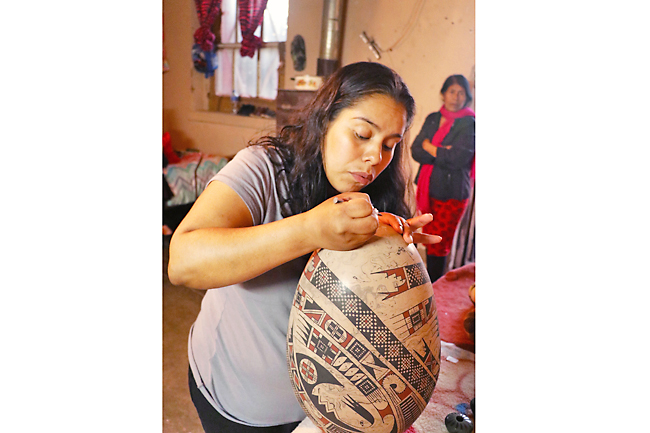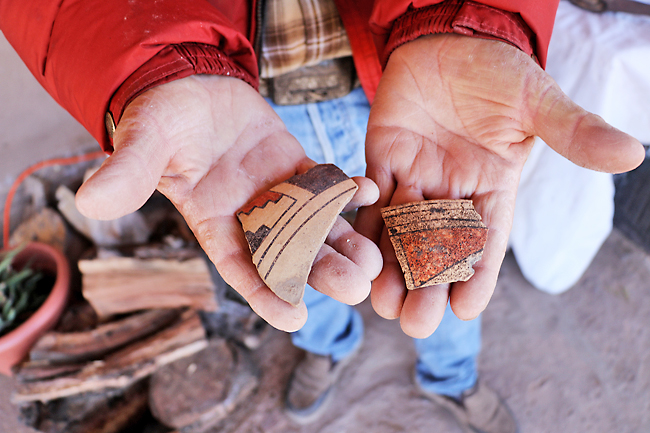Alex Pulaski
THE WASHINGTON POST – Most versions of the Mata Ortiz pottery pilgrimage, including the original one, start with a small store in a Southwest town. Ours was no different.
In Sedona, Arizona, and later Santa Fe, we stumbled upon bright, intricate pots in oranges, browns and blacks adorned with cranes, doves and pheasants. Small worlds carved into and painted upon fired clay.
We were hooked. On what, we knew not. My wife, Mica, and I bought a few pieces and started reading. The more we read, the closer we were drawn to a small village bearing an obscure general’s name in Chihuahua, a dry, northern Mexican state with a bloody history dating back to Pancho Villa and the Mexican Revolution in the early 20th Century.
This is a story about searchers: One man, Juan Quezada, a woodcutter who walked the hills with his eyes fixed on the ground looking for pottery shards, then perfected a method of making pots of his own. And another man, Spencer MacCallum, who came across some of those early pots in a New Mexico junk shop and traced them to the source, setting in motion events that would transform hundreds of lives, including his own.
I guess in a small way it’s about searchers like us, bumbling into Quezada’s century-old shop/store/home in Mata Ortiz in January 2020, when the pandemic was just a warning bell clanging faintly in the distance. We had come brimming with questions, which we unpacked before his wife, Guillermina.
She recalled the day, more than 40 years ago, when a local kid came knocking on her door with a White man – MacCallum – in tow. The man had brought some pottery with him.
“’I want to find whoever made these’,” she remembered him telling her in Spanish. “Mi esposo,” she replied. My husband.


Juan Quezada’s voice is deep and gravelly. His hands are gnarled, thick and sturdy.
At 81, he’s hard of hearing, and the threads of conversation occasionally seem to slip from his grasp.
But he is proud and patient and gracious, and when we asked him to spin his stories and show us the origins of his work, he readily agreed.
We climbed into a four-wheel-drive vehicle for a harrowing trip on crude, rocky roads into the hills, where he finds his clay deposits.
On the way, I asked him to flesh out what I had read: how, as a young man, six decades before, he had come across old pottery sherds while gathering wood in the hills.
No one made such pots anymore, and he began to wonder how these long-gone wanderers had done it. They had left behind no clues – only the ruins of a onetime thriving city in Casas Grandes, about 20 minutes from Mata Ortiz.
“I was always looking for stuff,” Quezada said in Spanish. “I loved the old things.” In an abandoned cave, he found an old pot, miraculously intact. “I took it in my hands,” he said, “and it came to my mind to make its equal.”
From then came a years-long process of trial and error: finding clay, learning how to fire it, experimenting with various animal hairs and plant fibers for paintbrushes.
Pot after pot broke because of impurities in the clay or flaws in the firing process, but he said he never grew frustrated.
“I kept at it,” he said. “I was not going to give up.”
Finally, a few of those early pieces held their integrity and were exchanged for some used clothing at Bob’s Swap Shop in Deming, N.M. – where MacCallum, a social anthropologist, wandered in and couldn’t get the mystery of those pots’ origins out of his mind. So he went looking for their creator.
That was 1976. In the ensuing years, MacCallum and his wife, Emi, invested their lives in creating a pottery-based economy in Mata Ortiz and introducing the work of Quezada and, ultimately, hundreds of others to dealers, collectors and galleries around the world.
Quezada’s work now sells for thousands of dollars. Other Mata Ortiz potters sell their work from anywhere from USD25 to USD2,500 and up, depending on their fame and the pot’s intricacy.
The village’s transformation is often referred to in media accounts as a “miracle.” Harder to divine is whether that miracle is attributable to Quezada, whose talent and tenacity resulted in the art, or MacCallum, whose unflagging energy opened a marketplace for Quezada and the rest of the village.
I put the question to Quezada’s wife as we sat in their home on our first afternoon there.
“Juan has so much talent that, one way or another, it was bound to come out,” Guillermina said. “But thank God for Spencer.”
The MacCallums moved to Casas Grandes nearly two decades ago and became unofficial ambassadors for Mata Ortiz and its residents.
They established a comprehensive website for visitors, with every detail imaginable, including their email address and phone number.
So I emailed and called him a handful of times in fall 2019 to plan our trip. This was before the coronavirus had reared its head.
Safety was at the top of our minds then for a different reason, given Mexico’s rampant narco-related violence.
Via phone, MacCallum assured me that Mata Ortiz would be “absolutely safe” for visitors.
(During a three-day visit to the area, my wife and I never felt unsafe, or even nervous. But we are both fluent in Spanish and have traveled extensively in Mexico.)
Our plan was for MacCallum to show us around and make the necessary introductions. But he was struck by a vehicle while walking in Deming, N.M., in early December 2019, suffering broken ribs, a broken hip, punctured lung and more.
We spoke by phone several months after my wife and I returned from Mexico. By then, the story based on our trip was stuck in a pandemic holding pattern, awaiting a vaccine rollout and some semblance of normalcy in the world of travel.
I didn’t hear until months later that Spencer MacCallum had died in December 2020 of pneumonia at 88. His ashes remain in Casas Grandes in a small shrine built by a friend, and Emi MacCallum still lives there.
During our visit to the area, we relied on local guide Diana Acosta to introduce us to families and show us around. We generally travel without a guide, but in this instance, I would recommend using one to assist with interpretation if needed, but more importantly to open doors to the homes where potters work.
For example, we watched one afternoon as Yadira Silveira Sandoval sat in her small kitchen and turned a lump of brown clay, like masa for tortillas, into a pot. She sat, pinching, pounding, shaving and turning, fast and silent.
“Lista,” she said 20 minutes later, placing the pot on the table and standing up. Ready.
On another afternoon, Yuli Gaona and her husband, Victor Solis, opened their home to us.
They were desperately poor, and they were relatively new to both pottery and Mata Ortiz, having moved from Guerrero (him) and Michoacán (her) – both states hit hard by drug violence.
Gaona learned to paint from her sister. The couple buy finished clay pieces, then sand and paint them. Both grandmothers were visiting, and they all slept together – the couple, a baby, a seven-year-old and the two grandmas – on three beds joined to make one.
We agreed to buy a pot, but when it became clear that it wouldn’t be fired until the following afternoon (when we planned to be driving north to the border), we elected to prepay USD20 for a pot we knew we would never see.
For established artists, however, pottery sales have translated to a ticket out of poverty – and in some cases, out of Mata Ortiz. Lydia Quezada, Juan Quezada’s youngest sister, and her husband, Rito Talavera, moved to nearby Nuevo Casas Grandes years ago. Their pleasant, modern house is decorated with museum-quality pottery pieces – some from Juan and her other siblings.
“He taught all of us,” she said. “He’s a talented teacher.”
She has passed that knowledge on to her children and grandchildren.
“I love to paint the pots and work with the clay,” she said in Spanish.
“It’s impressionable. I can shape, create and watch as it responds to my will.”
The restored pre-Columbian ruins of Paquimé in Casas Grandes gave the town its name – Spanish for “big houses” – from their stature, as much as six or seven stories when the Spanish arrived in the 16th Century. They lack the grandeur of Mexico’s better-known archaeological sites of Tenochtitlán, Chichén Itzá and Monte Albán, but the small, comprehensive museum there beautifully traces the history of the Mogollon people who inhabited it, as well as other regional Indigenous cultures.
The ruins’ mud-brown walls are thick and appear sturdy, but Acosta told us that they are actually fragile and look “like melting chocolate” when it rains.
Sometime around the 15th Century, Paquimé’s residents scattered, leaving behind the ruins, seashells that they hoarded by the millions and sherds of broken pottery.
The region’s Indigenous Tarahumara people continue to be on the move, fleeing to cities to avoid narcos’ operations in the mountains.
They had settled there to escape the Spanish conquistadors, and later the violence of the
Mexican Revolution. On the drive between Casas Grandes and Mata Ortiz, a brief side trip down a gravel road delivered us to the Hacienda de San Diego, the onetime home of Don Luis Terrazas, who owned much of Chihuahua.
His initials remain emblazoned on the building’s exterior, but the building has passed into the hands of Acosta’s family.
She fondly remembers the annual Gathering of the Friends of Mata Ortiz, which, since the mid-1990s, had annually brought several dozen Americans here in the fall for a few days. Visitors left with boxes of pottery, and locals were flush with cash.
But with the passage of time, the MacCallums began to slow down, as did many of their contemporaries.
Some ran into health issues, and the gathering hasn’t happened since 2018. Locals were hit hard by the Great Recession, which interrupted the procession of visitors and buyers, and the coronavirus pandemic has also taken an enormous economic toll.
“Some of our best potters started working in the fields or cleaning houses,” Acosta told me recently by phone.
Over the past few months, however, visitors have started coming back. Restaurants and shops are open, and masks are required. Acosta hopes to honor Spencer MacCallum in October at a reborn Gathering of the Friends of Mata Ortiz.
“Before 2008, I was one of the people who thought Mata Ortiz would turn into another San Miguel de Allende,” Acosta told me during our visit there, speaking of the thriving artist/expat community in the Mexican state of Guanajuato.
Leaving the thought unfinished, she resumed a tour of the sprawling hacienda. Much of it is a crumbling ruin. Its exterior walls are scarred with bullet holes, a reminder of the Mexican Revolution.
But a restored bedroom is lovely. Her mother’s kitchen, replete with the wood-burning stove where she teaches Mexican cooking and serves hot chocolate to tourists, is immaculate.
“Our dream,” Acosta said, “is that one day all this will be restored.”
She was talking about the building. But on the drive north to the border, I couldn’t help wondering whether others might possess the perseverance and ingenuity to pick up the shards buried for miles around here and construct something new from them.






